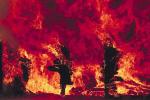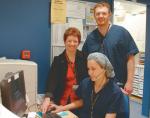Trial by fire for online disaster simulation
A new online program is helping to prepare for the unthinkable. A University of Adelaide team has created the disaster simulation program which can prepare responders to crises such as terrorist bombings, hurricanes, bushfires, industrial explosions and train crashes. The multi-disciplinary team combined their skills, expertise and experience to develop the "Through the Fire" simulation program, which focuses on the response to mass burn casualties at a simulated Australian military installation in Central Australia. "Through the Fire" is based on an online simulation (or e-sim) co-developed by Dr Holger Maier from the School of Civil and Environmental Engineering. Set in the Mekong River Region of South-East Asia, the Mekong e-sim has won numerous teaching awards and has been praised by hundreds of students. For "Through the Fire", Dr Maier enlisted the help of Ms Sheila Kavanagh, a Burns Nurse educator from the Department of Clinical Nursing, who was involved in the response to the Bali bombing disaster and received an Order of Australia for her contribution, and Mr Allan Carrington, Instructional Designer from the Learning and Teaching Development Unit (LTDU). Also involved were Judi Baron and Dayle Hall, experts in online delivery from the LTDU, and Dr Randall Kindley, an expert in simulation and scenario-based learning, from The Performance Group based in Minnesota in the USA. "In the wake of escalating risks, many organisations are developing response plans to cater for a potential disaster," Dr Maier said. "We reasoned that online role-play simulations and scenario-based learning were an alternative to expensive physical simulations for testing and familiarising emergency response teams with such plans." At this pilot stage, the only participants are burns nurses, but there are plans to expand the simulation to include other disciplines. "It is quite difficult to familiarise first responders with the hectic environment and help them make good decisions under extreme stress. Too often, these issues take second place to emergency plan tests that are primarily concerned with infrastructure," Ms Kavanagh said. "Studies like the United States' September 11 reports showed that it is the skill level of responders that determine success. However, a simulated emergency response event is often too expensive to obtain this training." Mr Carrington said this is a learning and teaching methodology whose time has come. "Over the last few months, there has been growing interest in this work, with the collaborators giving a multimedia presentation at an online conference on e-learning hosted by the University of Calgary," Mr Carrington said. "We were recently involved in a live webcast on the work to a worldwide audience of educators. As a result of this presentation, we have been invited to present six more online events to learning communities of over 20,000 educators before the end of the year."
|






